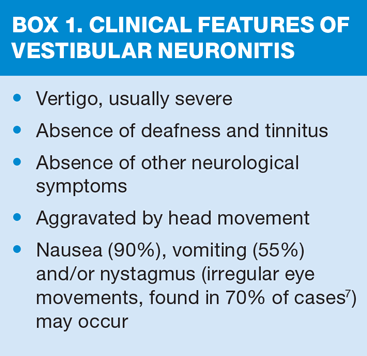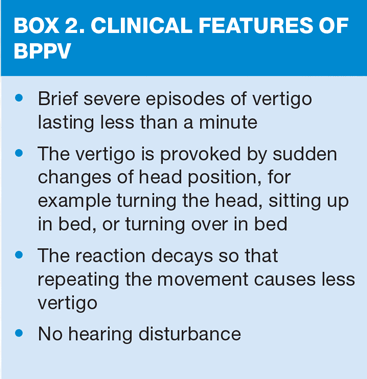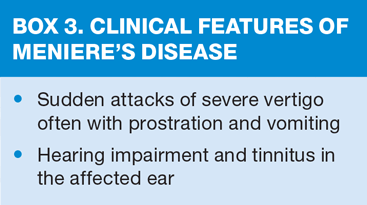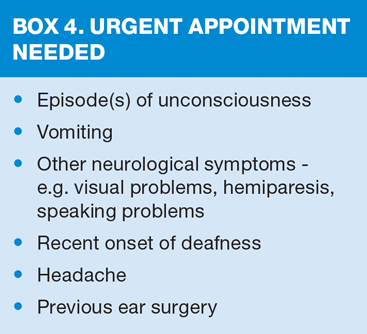Neurological symptoms in primary care Part 1: Dizziness
Dr Ed Warren
Dr Ed Warren
FRCGP, FAcadMEd
Lack of knowledge of neurological symptoms can lead to failure to recognise conditions that may require rapid referral and treatment. In this series we look at commonly presenting signs and symptoms, explore their possible causes and flag up those that need urgent attention
For many people living with neurological conditions, primary care is a crucial stage of the care pathway. It is frequently the first point of contact with the health system for people who have begun to notice that something may be wrong. As such, patients rely on primary care services to provide an accurate initial assessment and subsequently an appropriate referral to the right specialist. This enables patients to receive a diagnosis and access the correct treatment, support and advice as soon as possible.
Unfortunately, the transition from primary to secondary care services can be a lengthy process. A survey of just under 7,000 people carried out in 2014 found that the majority of people with neurological conditions wait over 12 months between first presenting in primary care and receiving a confirmed diagnosis.1 For the majority of patients, this wait involves five or more visits to a primary care clinician before receiving a referral to a specialist, although it must be emphasised that not all neurological symptoms are indicative of a serious condition.
In comparison to the most prevalent long-term conditions such as diabetes, many neurological conditions present relatively infrequently to primary care. Based on the latest prevalence estimates of over 40 neurological conditions, including epilepsy, Parkinson’s disease and multiple sclerosis, the Neurological Alliance estimates that the number of neurological cases in England alone had reached 12.5 million in 2014.1
Current guidance focuses more strongly on the ongoing management of these conditions than on initial assessment and referral. NICE is currently developing guidance on the assessment of suspected neurological conditions in primary care, expected to be published in January 2018, but until such times, this guide to common neurological symptoms aims to provide general practice nurses with an overview of their significance and how to proceed.
DIZZINESS
Balance is the sense of continuity that a person has with their environment. Maintaining balance is quite a complicated process requiring several things to be working properly:2
- Accurate neurological input from:
- eyes (visual clues telling you which way up your head is),
- joints (receptors ‘report in’ which way your joints are pointing - proprioception),
- balance mechanism in the inner ear (vestibular labyrinth).
- Adequate co-ordination of the neurological input by the brain.
- Sufficient neurological output from the central nervous system to limbs which will respond to correct episodes of imbalance.
It is not surprising therefore that loss of balance and dizziness is relatively common. The usually reported community prevalence of dizziness is 10% for women and 6% for men, but one study reported that 20% of adults experienced dizziness in a given month, and 35% in a given 5 year period.3 Only a small proportion of people with dizziness are seen in general practice.
Dizziness is disabling. Half of those with dizziness report some degree of handicap as a result, and 40% of those with jobs report problems at work.3 Dizziness causes anxiety and anxiety can cause dizziness.4 The chance of dizziness increases with age so that by age 65 up to a quarter of people will suffer from dizziness, and by age 90 around half of people are affected.4,5
Most cases of dizziness seen in general practice are managed without referral to hospital or special tests and investigations, with only 15% sent to see secondary care colleagues.6
‘WHAT DO YOU MEAN BY DIZZINESS?’
Dizziness may be usefully divided into two types: vertigo; and everything else. Of those people who attend general practice with their dizziness, roughly half will have vertigo.4,6
Vertigo is an illusion or hallucination of movement, usually rotational, either of oneself or the environment.6 In its mildest form it may present as a rocking sensation. The following question is useful to ask as it has been shown to be a good way of detecting vertigo.7
‘When you have dizzy spells, do you just feel light-headed or do you see the world spin round you as if you had just got off a playground roundabout?’
When vertigo is encountered in general practice, the problem is nearly always due to a balance organ disorder in the inner ear. Other causes are not unknown, but are very much in the minority.
VERTIGO – THE LIKELY CAUSES
Just three conditions are responsible for nearly all the vertigo seen in general practice, with Ménière’s disease running a poor third to the other two possible causes.
1. Vestibular neuronitis
This is a condition that typically affects young to middle-aged adults (20 to 60). It comes on with alarming suddenness, and may be so severe that the sufferer is unable to get out of bed. As it affects people of working age and those with responsibility for child rearing, the effects can be highly disruptive. Some people describe the problem as being like sea-sickness.
In half of cases an attack comes on after a minor illness, with a particular culprit being sinusitis. Because of this the condition is sometimes referred to as ‘viral labyrinthitis’, but strictly the labyrinth is not involved. The term vestibular neuronitis is preferred.
Treatments can be used to reduce symptoms, yet vestibular neuronitis basically gets better on its own, but this may take several weeks with gradually reducing symptoms (Box 1).
2. Benign Paroxysmal Positional Vertigo (BPPV)
This affects an older age group (50 to 70). It is characterised by short episodes of vertigo, typically on head movement – for instance getting into or getting out of bed (Box 2). BPPV is brought about by degeneration in the vestibule of the semi-circular canals of the inner ear. Sufferers get better over a period of weeks or months of reducing symptoms, but attacks may recur. Special head movements can be used to correct the degeneration (for instance, the Epley manoeuvres – a series of controlled movements designed to restore the function of the semi-circular canals).
Drug treatments are available to ease symptoms. However, medications are no longer recommended: they do not hasten resolution of symptoms, and run the risk of drug side effects (e.g. drowsiness, and sometimes a Parkinson’s- like problems with abnormal movements, neither of which are desirable when treating a liability for falls).9 Despite this, medication is often prescribed because short-term relief is welcomed especially as vertigo is often accompanied by a fear of what would happen if an attack occurred in a dangerous situation.
3. Ménière’s Disease
Ménière’s disease is characterised by attacks of severe vertigo and vomiting which come on quite suddenly (Box 3). Attacks may last from 10 minutes to 12 hours, and often need urgent drug treatment. A big difference with other forms of vertigo is that the hearing is affected, and sufferers frequently end up quite deaf in the affected ear. Apart from the deafness, patients are normal between episodes. Luckily the condition is uncommon. Most sufferers will benefit from an outpatient assessment.
OTHER TYPES OF DIZZINESS
Into the ‘everything else’ category of dizziness comes ‘pre-syncope’: the sensation of an impending faint, a light-headed feeling which may lead to a full-blown faint. The underlying problem with this symptom is likely to be a temporary reduction in brain blood supply. This diagnosis can be reinforced if there has been a witness to the dizzy spell, who will commonly confirm that the patient went a ‘funny’ pale colour during the episode – often described as like ‘death warmed up’, an unfortunate phrase as death is a most unlikely outcome.
Pre-syncope is readily distinguished from vertigo because there is no sensation of movement. Taking a careful and detailed history of episodes it is usually possible to make the distinction. In addition, many people will have had an episode of light-headedness at some time in their previous life as it is not uncommon in adolescence when blood pressure is naturally rather lower so that brain blood flow is a bit more precarious: making the comparison helps with determining the nature of the dizziness.
Pallor and sweating often accompany the faint feeling. Over a 10 year period around a quarter of elderly people will have a faint, and in most cases this is not reported to a doctor. About 3% of emergency visits to hospital are the result of a faint, and a third of patients require admission.10 Cough and micturition may cause attacks. Vaso-vagal syncope affects a younger age group, commonly adolescents, and has no long-term consequences. Prolonged syncope can result in a seizure, and hours of tiredness afterwards.
Postural hypotension occurs when blood pressure drops when a patient stands up, and this may result in a faint feeling. Using strict criteria, the pressure should drop 25/15mmHg to confirm this condition, but just getting a history of when the faints occur usually suffices. One important cause of postural hypotension is the over-zealous drug treatment of hypertension. Caution should be exercised in treating hypertension in elderly patients, and based on 35 years in practice I would suggest that over the age of about 60 years more good is done by stopping drugs than by starting them. Other causes of pre-syncope include heart rhythm irregularities, and heart failure. In addition, if blood quality is impaired (e.g. anaemia) this may also result in insufficient blood getting to the brain.
Disequilibrium is a sense of imbalance not associated with movement. It is the product of multiple deficits in the balance-maintaining mechanisms and so is particularly prevalent in the frail elderly. Vision tends to deteriorate with age, so that the normal visual cues are less useful. In addition, joints that are arthritic are less likely to provide reliable proprioception information. Cognitive impairment such as dementia may limit the brain’s ability to process the balance data it is receiving.
Falls are common in the elderly, and a frequent cause of injury and death.11 The cause of the fall may be described as ‘dizziness’ but it will not readily fit into one of the categories described above. Descriptions of ‘legs going weak’, or ‘I felt dizzy and I went down’ are characteristic. There is usually a background of more than one degenerative disorder in a patient with poor levels of confidence, for instance poor vision, impaired proprioception from arthritic joints and cervical spondylosis.12 In some cases an additional problem such as a chest infection or mild heart failure can tip the balance and produce falls.
RED FLAGS
A dizzy spell is always a frightening event. The event itself is deeply unpleasant. You have to stop what you are doing. There is a feeling of being out of control, and at possible risk of falls and injury: ‘What would happen if I was crossing the road?’ In addition, though the causes of dizziness discussed above are by far the most likely ones to have, they are not the only ones. Just occasionally there may be a more serious cause, and this will almost certainly be in the mind of your patient. For example, there is a form of benign tumour called an acoustic neuroma which, while not malignant, can cause symptoms of vertigo because of pressure as it grows. For another example, around 5% of people with multiple sclerosis will experience vertigo as their first symptom.13 By contrast, earwax can also cause dizziness.14
So anyone who presents with an episode of dizziness merits an appointment with a GP, if only for reassurance. In some instances that appointment should be urgent as it may be that one of the more unusual causes of dizziness is the culprit (Box 4). In other instances, a routine booking is more appropriate, but be aware that the wait for a routine appointment can be 2 weeks or more. Patient want rather than need can result in an urgent appointment for reassurance.
If the dizziness comes on suddenly, without provocation, and is severe enough to be disabling, then your patient should not drive a car until the symptoms are satisfactorily controlled. For bus and lorry drivers the rules are rather stricter so that the dizziness needs to have stopped for 12 months before driving can resume.15 If there is any doubt, your patient should notify the DVLA.
WHAT HAPPENS NEXT?
When a referral to hospital is made, particularly if the dizziness is vertigo, then it will be the Ear, Nose and Throat specialists who will become involved. As well as securing the diagnosis (and ruling out anything sinister) they can often suggest or implement treatments which may not be available in general practice. An example would be the exercises used for BPPV, though many GPs are able to do this treatment in the surgery.
- If falls are a problem, then the local Physiotherapy department or Occupational Therapy department may be able to help with advice and aids.
- The British Red Cross may be able to help with wheelchairs and other mobility aids). They have a network of local offices around the country which can be located through the website www.redcross.org.uk
- The Brain and Spine Foundation offers information and support. They produce a booklet called ‘Dizziness and balance problems’. http://www.brainandspine.org.uk/dizziness-and-balance-problems
- The Ménière’s Society mainly focuses on the eponymous disease, but also offers more general support and advice especially for people suffering from vertigo. http://www.menieres.org.uk/
- For a more in-depth trawl of the medical aspects of dizziness, try Vertigo – NICE CKS http://cks.nice.org.uk/vertigo
CONCLUSION
Careful assessment of patients complaining of dizziness can help to ensure that they are reassured, referred to the GP or to secondary care in a more timely fashion, bearing in mind that even when there is no serious cause, these symptoms can be distressing and disabling.
NEXT TIME – Numbness
REFERENCES
1. Neurological Alliance. The invisible patients: revealing the state of neurology services, 2015. http://www.neural.org.uk/store/assets/files/495/original/Invisible_patients_-_revealing_the_state_of_neurology_services_final_14_January_2015_.pdf
2. Ludman H. ABC of ear nose and throat. 2nd edition. British Medical Association. London,1988.
3. Bain J. Natural history and management of dizziness: putting evidence into practice. Br J Gen Pract 1998;48:1128-9.
4. Yardley L and Luxon L. Treating dizziness with vestibular rehabilitation. Br Med J 1994;308:1252-3.
5. Jönsson R, Sixt E, Landahl S, Rosenhall U. Prevalence of dizziness and vertigo in an urban elderly population. J Vestib Res. 2004;14(1):47-52.
6. Hanley K and O’Dowd T. Symptoms of vertigo in general practice: a prospective study of diagnosis. Br J Gen Pract 2002;52:809-812.
7. Hanley K, O’Dowd T and Considine N. A systematic review of vertigo in primary care. Br J Gen Pract 2001;51:666-671.
8. Cooper C W. Vestibular neuronitis: a review of a common cause of vertigo in general practice. Br J Gen Pract 1993;43:164-7.
9. NICE CKS Benign paroxysmal positional vertigo. http://cks.nice.org.uk/benign-paroxysmal-positional-vertigo [Accessed 24.10.16]
10. Petch M C. Syncope. Br Med J 1994;308:1251-2.
11. Luxon L M. Assessment and management of vertigo. Presc J 1998;38(2);87-97
12. Overstall P W. A protocol for the diagnosis of balance problems. Care of the Elderly. 1992;4:174-5.
13. Fowler T J. Assessment and management of vertigo and dizziness. UPDATE 1991;43:337-49.
14. Booton P. Diagnosing dizziness. UPDATE 1992;45:270-5.
15. DVLA. Assessing fitness to drive. https://www.gov.uk/government/uploads/system/uploads/attachment_data/file/526635/assessing-fitness-to-drive-a-guide-for-medical-professionals.pdf



